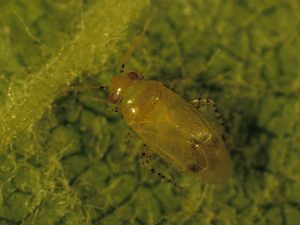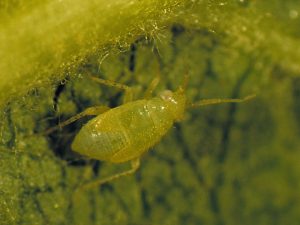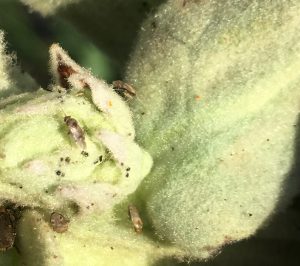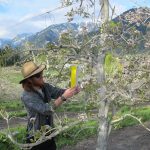Written by Christopher Strohm, WSU Extension. July, 2018
Why Campylomma bugs are important
The Mullein plant bug, Campylomma verbasci (Meyer), or ‘campy’ functions as an herbivore and a predator in pear orchards (unlike in apples where it is a direct fruit pest in the early season). Both adults and nymphs feed on a variety of soft-bodied insects, mites, and their eggs. One nymph is capable of eating more than 600 pear psylla eggs during development (Fields & Zwick, 1977). They are also known to feed on tender summer shoots of pears when they first emerge. Campys are an important member of the natural enemy community that controls pear psylla for several reasons:
- They emerge early, usually just after bloom when orchards have remained unsprayed for two weeks due to pollination.
- They appear to be present in upper canopy areas where summer generation psylla prefer to lay eggs.
- Campys go through as many as four generations each season, allowing them to build a population in response to a growing psylla population.
Campylomma in Wenatchee Valley Pear Orchards
Sampling for Campylomma in the early season requires beat trays as there are no adults present yet. In summer, beat trays as well as yellow sticky cards with a synthetic sex pheromone lure can be used. In 2017, Campylomma nymphs were first found in beat trays in late May and the first adults came to traps in early June. Nymphs and adults were abundant from June to October. Campylomma were always more common in pear orchard blocks using organic materials or an IPM spray program than in conventional blocks. To see 2017 scouting data, check out the scouting page here: https://treefruit.wsu.edu/crop-protection/pear-ipm/scouting2017/
Identification
Campys are true bugs, they have piercing/sucking mouthparts. Adults are 2-3 mm long with a yellow to brown colored body and black spines on the hindlegs (Photo 1). Nymphs are translucent to bright yellow-green and are 0.5-3 mm, as they develop, they too will have black spines on the legs (Photo 2).


Biology
This insect overwinters in the egg stage. Overwintering eggs are laid in woody plant tissue and will hatch in late April or May. The woody plant host can be a pear or apple tree. Several other known hosts include serviceberry, grapes, oak, and wild rose (Beers, 1993). During summer, a portion of the Campylomma population moves to herbaceous plant hosts such as Mullein (Photo 3). Summer eggs are laid in herbaceous plant tissue or the midrib of tree fruit leaves. There are 2-4 generations each season in the pacific northwest.

Additional Information:
https://treefruit.wsu.edu/crop-protection/opm/
https://treefruit.wsu.edu/crop-protection/pear-ipm/.
References
Beers, E.H., Campylomma (Mullein plant bug). (1993). from Orchard Pest Management (Beers, E. H. & Brunner J. F., editors). WSU/Washington State Fruit Commission.
Fields G. J. & Zwick R. W. (1977). Integrated Control of Pear Psylla in Oregon’s Hood River Valley. OSU Agricultural Experiment Station, Circular of Information, 660.
Acknowledgements
This project was funded in part by a grant from WSDA Specialty Crop Block Grant K1986.
Contacts
Extension Assistant, Pear IPM
WSU Tree Fruit Research and Extension Center
509-663-8181 ext. 233
Fruit Matters articles may only be republished with prior author permission © Washington State University. Reprint articles with permission must include: Originally published by Washington State Tree Fruit Extension Fruit Matters at treefruit.wsu.edu and a link to the original article.

